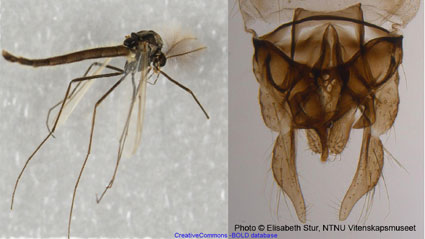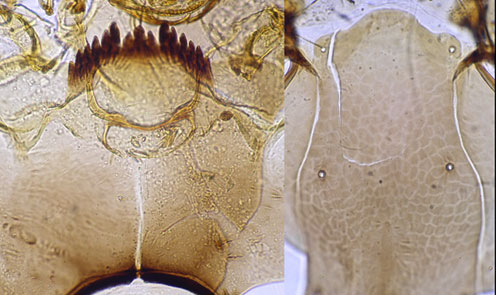Chironomus species 1TE, from BOLD DatabaseAlso referred to in BOLD database as C. cf. saxatilis - incorrect association (Stur & Ekrem 2020). In BOLD Bin: BOLD:AAC0592. It is possible that this is the species recorded as C. riparius in Greenland. Adult:  Dark species, thorax, abdomen and legs blackish brown. Wing length about 3 mm, width about 0.8 mm, VR about 0.94; AR perhaps 3.5; LR about 1.4-1.5 About 6-9 setae on tergite IX, each in a separate patch. Anal point narrow, SV similar to C. holomelas, C. saxatilis closest to Strenzke's S(c)-type; style narrowing over posterior half. Pupa: Not known. Larva: (based on Greenland specimens): A small-moderate halophilus-type (males 11.7-12.2 mm), ventral tubules short, posterior pair usually longer (0.24-0.40; 0.28-0.40 mm), anal tubules long with constriction in middle, dorsal abt. 380-825 µm; abt 2-4 times longer than wide; abt 2.9-3.7 times longer than wide (dors. 690 x 200; vent. 690 x 210 µm).  Mentum (Fig. c) with 4th laterals reduced about halfway to height of 5th laterals (type I-II), central trifid tooth probably type III, but wear may make it appear as type IB or type IV. Larval characters, particularly of the antenna, are quite variable. While nothing is known of the larval habitats, it is possible that this is due to ecological difference which may influence the length of the life cycle, which is known to extend up to 7 years in some high northern species (Butler 1982), i.e. there may be members of different cohorts. Cytology: 4 polytene chromosomes with the pseudothummi arm combination AE, BF, CD, G. Molecular sequence: mtCOI: Sequence for this species is in the BOLD database where it is placed in BOLD BIN AAC0592. However, the sequence for one of the available larvae shows only about 94% similarity, and is described elsewhere as a potential closely related species, Species 5h for which there is no sequence in GenBank or the BOLD database. Another larva from Peary Land has a COI sequence most closely related to Sp. 1TE, and there are some differences in the larvae - however, the larva shows a number of malformations so is not certain just how real some of these differences are. Length about 10.8 mm, ventral tubules shorter than those of other available specimens: anterior 0.18 mm. posterior 0.24 mm; anal tubules much shorter 300-400 µm (ventral pair longer) and about 1.9-1.8 times longer than wide. Head capsule generally dark, gula darkened over posterior 2/3. Salivary reservoir abt 76 x 25 µm (3.03 times longer than wide). Distance between the S4 setae (147 µm) less than that between the antennal bases (179.5 µm), but the setae are closer to the margin (0.97 of width of frontoclypeus between them). S5 setae slightly posterior to the nearby RO. Mentum (Fig. c) with 4th laterals reduced about to level of 5th laterals (type II) and central tooth probably type IIA. Ventromentum (Fig. d) and Pecten epipharyngis (Fig. a) as in other larvae; Premandible not clear. Antenna (Fig. b) with measures within thee ranges of the Sp. 1TE larvae, lengths 140 ; 34 ; 10 ; 12.5 ; 9. AR 2.17; RO about 1/3 up from base of A1; A2 abt 1/4 of length of A1 which is 0.47 of the VHL and 2.7 times longer than wide; A5 abt 0.88 the length of A4. Mandible (Fig. e) of type II-IIIB, about 260 µm long; 17-18 furrows on the outer surface near the base; 13-15 taeniae in PecM; Mdt-Mat 30 µm, MTR 0.38. Found: Northwest Territories-Aulavik National Park (73.71°N;, 119.92°W), Banks Island C. saxatilis was described by Wülker et al. (1981) with the type specimen a polytene chromosome squash. It has been suggested that it is a synonym of C. lugubris (Lindeberg, unpubl.), although this is not supported by COI sequence data. It is very similar in morphology to C. holomelas, such that Wülker et al. did not see the necessity of illustrating the male terminalia. The polytene chromosomes suggest that the present species cannot be C. saxatilis, but is closely related and does not match any cytologically studied species from the Holarctic. |
Modified: 6 December 2024
Access: Unrestricted
Copyright © 2017-2024, Jon Martin.